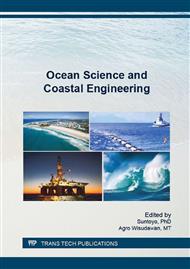p.161
p.168
p.174
p.182
p.189
p.197
p.202
p.208
p.214
Groundwater Profile Model around Mud Reservoir and Sidoarjo Coastal Area
Abstract:
Sidoarjo mud flow has continued for more than 9 years with bursts volume reached 105m3/day and needed time to stop the burst reach 8907 years. Mudflow can affect the condition of the water table around mud reservoir. It is based on research conducted by Mustain (2013), this result showed mud reservoir can affect water table profile 2 km to the east and 1,5 km to the west. The purpose of research is to determine the profile of topography and water table around mud reservoir and Sidoarjo coastal area for another directions. Then to make topography and water table profile model. Field sampling were have been done by measuring the depth of wells that located around the mud reservoir. To determine changes in water table that occur used trendline of microsoft excel. The results obtained the groundwater profile models in the form of graphs, each direction from mud reservoir with x axis as distance from central of mud flow with a certain direction and y axis as depth of the water table and topography elevation. The graph results showed that mud reservoir can affect water table profile 1.5 km to the southwest, 1.3 km to the south, 1.6 km to the southeast, 1.7 km to the northeast, 1.7 km to the north dan 1.5 km to the northwest. The validation of these numbers are depend on the accuration of trendline in the microsoft excel system.
Info:
Periodical:
Pages:
189-194
Citation:
Online since:
January 2017
Authors:
Keywords:
Price:
Сopyright:
© 2017 Trans Tech Publications Ltd. All Rights Reserved
Share:
Citation:


